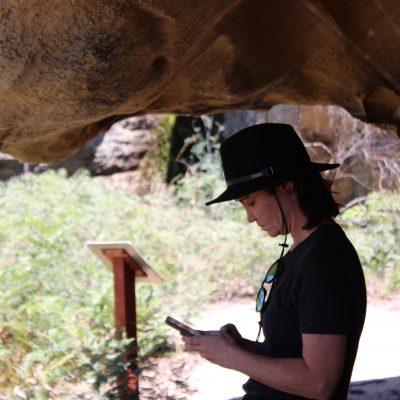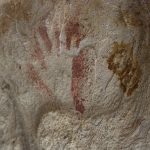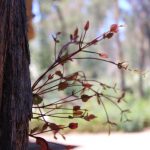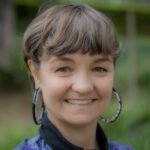Ngaa-bi-nya was developed by Megan Williams over a period of 15 years, while working in service delivery and program creation and evaluation.

Megan often drew on the Context, Input, Processes, Products (CIPP) model of Stufflebeam,[1]Stufflebeam DL. (2003). The CIPP model for evaluation. In DL Stufflebeam & T Kellaghan (Eds.), The international handbook of educational evaluation (pp. 31–62). Boston, MA: Kluwer Academic … Continue reading which asks four overarching questions: What needs to be done? How should it be done? Is it being done? Is it succeeding?
She added prompts to the CIPP model to ensure that data about cultural and contextual factors relevant to Aboriginal and Torres Strait Islander people and programs were consciously collected, analysed and reported. In time, she refined these prompts and developed a stand-alone framework.
In 2008 Megan worked with the International Union of Health Promotion and Education South West Pacific Group, the Australian Health Promotion Association, the Cooperative Research Centre for Aboriginal Health and the Queensland Aboriginal and Islander Health Council to host an interactive Population Health Congress 2008 workshop on ‘What constitutes success in Aboriginal and Torres Strait Islander health?’[2]Erben R, Judd J, Ritchie J & Rowling L. (2009). Success stories: Environmental, social, emotional and spiritual health of Aboriginal and Torres Strait Islanders. Darwin, NT, Australia: … Continue reading
This collaboration led to a series of workshops in 2010 for the 20th International Union for Health Promotion and Education World Conference on Health Promotion about the nature of evidence for effectiveness in Indigenous health programs.
These diverse engagements with Indigenous peoples internationally, as well as from urban, regional, and remote Australia, took place while she was doing a literature review for doctoral studies about definitions of success and effectiveness in health and criminal justice programs.[3]Williams M. (2015). Connective services: Post-prison release support in an urban Aboriginal population (Doctoral dissertation). Sydney: UNSW Sydney, Australia
Collaboration with Aboriginal organisations through Project 10%, an Aboriginal-led campaign to reduce incarceration rates, resulted in clarification of indicators of quality and effectiveness to advocate to governments[4]Williams M. (2011). Wundirra: Standing in the light of Aboriginal and Torres Strait Islander people. Brisbane, Qld, Australia: Project 10% and to guide the selection of 20 success stories showcased in an Aboriginal community publication.[5]Williams M. (2016). Be the best you can. In S. Finlay, M. Williams, M. Sweet, M. McInerney, & M. Ward (Eds.), #JustJustice: Tackling the over-incarceration of Aboriginal and Torres Strait … Continue reading
The opportunity to evaluate an Aboriginal male well-being program, Be the Best You Can Be, which accompanies the Australian feature film Mad Bastards, saw the refinement and naming of Ngaa-bi-nya in 2012. A diverse, eight member Mad Bastards Working Group of experienced Aboriginal service providers from across Australia had several discussions about evaluation, and the need for tools that capture social, cultural, and economic influences on individuals and programs,[6]Haswell M, Blignault I, Fitzpatrick S & Jackson Pulver L. (2013). The social and emotional wellbeing of Indigenous youth: Reviewing and extending the evidence and examining its implications for … Continue reading which could be discerned from program influences. This reflected work by Haswell, Blignault, Fitzpatrick and Jackson Pulver on a set of critical success factors from case studies with six Indigenous youth social and emotional well-being programs.[7]Haswell M, Williams M, Blignault I, Grande M & Jackson Pulver L. (2014). Returning home, back to community from custodial care: Learnings from the first year pilot project evaluation of three … Continue reading
In working with Haswell, Blignault and Jackson Pulver on evaluation of three diverse post-prison release support programs around Australia for Aboriginal and Torres Strait Islander women, the Returning Homeprogram, Megan developed another iteration of Ngaa-bi-nya. She clarified how Ngaa-bi-nya related to critical success factors, and that Ngaa-bi-nya should be considered an overall framework to guide evaluation that prompts the user to select methods and data, rather than simply as a data collection tool in itself.
Ngaa-bi-nya (pronounced naa-bi-nya) means to examine, try and evaluate in the language of the Wiradjuri people of central NSW.
References
| 1 | Stufflebeam DL. (2003). The CIPP model for evaluation. In DL Stufflebeam & T Kellaghan (Eds.), The international handbook of educational evaluation (pp. 31–62). Boston, MA: Kluwer Academic Publishers |
|---|---|
| 2 | Erben R, Judd J, Ritchie J & Rowling L. (2009). Success stories: Environmental, social, emotional and spiritual health of Aboriginal and Torres Strait Islanders. Darwin, NT, Australia: Cooperative Research Centre for Aboriginal Health |
| 3 | Williams M. (2015). Connective services: Post-prison release support in an urban Aboriginal population (Doctoral dissertation). Sydney: UNSW Sydney, Australia |
| 4 | Williams M. (2011). Wundirra: Standing in the light of Aboriginal and Torres Strait Islander people. Brisbane, Qld, Australia: Project 10% |
| 5 | Williams M. (2016). Be the best you can. In S. Finlay, M. Williams, M. Sweet, M. McInerney, & M. Ward (Eds.), #JustJustice: Tackling the over-incarceration of Aboriginal and Torres Strait Islander peoples (2nd ed., pp. 18–20). Sydney, NSW, Australia: Croakey |
| 6 | Haswell M, Blignault I, Fitzpatrick S & Jackson Pulver L. (2013). The social and emotional wellbeing of Indigenous youth: Reviewing and extending the evidence and examining its implications for policy and practice. Sydney, NSW, Australia: Muru Marri, UNSW |
| 7 | Haswell M, Williams M, Blignault I, Grande M & Jackson Pulver L. (2014). Returning home, back to community from custodial care: Learnings from the first year pilot project evaluation of three sites around Australia. Sydney, Australia: Muru Marri, UNSW |
Ngaa-bi-nya was developed by Megan Williams over a period of 15 years, while working in service delivery and program creation and evaluation.
Megan often drew on the Context, Input, Processes, Products (CIPP) model of Stufflebeam,[1]Stufflebeam DL. (2003). The CIPP model for evaluation. In DL Stufflebeam & T Kellaghan (Eds.), The international handbook of educational evaluation (pp. 31–62). Boston, MA: Kluwer Academic … Continue reading which asks four overarching questions: What needs to be done? How should it be done? Is it being done? Is it succeeding?
She added prompts to the CIPP model to ensure that data about cultural and contextual factors relevant to Aboriginal and Torres Strait Islander people and programs were consciously collected, analysed and reported. In time, she refined these prompts and developed a stand-alone framework.
In 2008 Megan worked with the International Union of Health Promotion and Education South West Pacific Group, the Australian Health Promotion Association, the Cooperative Research Centre for Aboriginal Health and the Queensland Aboriginal and Islander Health Council to host an interactive Population Health Congress 2008 workshop on ‘What constitutes success in Aboriginal and Torres Strait Islander health?’[2]Erben R, Judd J, Ritchie J & Rowling L. (2009). Success stories: Environmental, social, emotional and spiritual health of Aboriginal and Torres Strait Islanders. Darwin, NT, Australia: … Continue reading
This collaboration led to a series of workshops in 2010 for the 20th International Union for Health Promotion and Education World Conference on Health Promotion about the nature of evidence for effectiveness in Indigenous health programs.
These diverse engagements with Indigenous peoples internationally, as well as from urban, regional, and remote Australia, took place while she was doing a literature review for doctoral studies about definitions of success and effectiveness in health and criminal justice programs.[3]Williams M. (2015). Connective services: Post-prison release support in an urban Aboriginal population (Doctoral dissertation). Sydney: UNSW Sydney, Australia
Collaboration with Aboriginal organisations through Project 10%, an Aboriginal-led campaign to reduce incarceration rates, resulted in clarification of indicators of quality and effectiveness to advocate to governments[4]Williams M. (2011). Wundirra: Standing in the light of Aboriginal and Torres Strait Islander people. Brisbane, Qld, Australia: Project 10% and to guide the selection of 20 success stories showcased in an Aboriginal community publication.[5]Williams M. (2016). Be the best you can. In S. Finlay, M. Williams, M. Sweet, M. McInerney, & M. Ward (Eds.), #JustJustice: Tackling the over-incarceration of Aboriginal and Torres Strait … Continue reading
The opportunity to evaluate an Aboriginal male well-being program, Be the Best You Can Be, which accompanies the Australian feature film Mad Bastards, saw the refinement and naming of Ngaa-bi-nya in 2012. A diverse, eight member Mad Bastards Working Group of experienced Aboriginal service providers from across Australia had several discussions about evaluation, and the need for tools that capture social, cultural, and economic influences on individuals and programs,[6]Haswell M, Blignault I, Fitzpatrick S & Jackson Pulver L. (2013). The social and emotional wellbeing of Indigenous youth: Reviewing and extending the evidence and examining its implications for … Continue reading which could be discerned from program influences. This reflected work by Haswell, Blignault, Fitzpatrick and Jackson Pulver on a set of critical success factors from case studies with six Indigenous youth social and emotional well-being programs.[7]Haswell M, Williams M, Blignault I, Grande M & Jackson Pulver L. (2014). Returning home, back to community from custodial care: Learnings from the first year pilot project evaluation of three … Continue reading
In working with Haswell, Blignault and Jackson Pulver on evaluation of three diverse post-prison release support programs around Australia for Aboriginal and Torres Strait Islander women, the Returning Homeprogram, Megan developed another iteration of Ngaa-bi-nya. She clarified how Ngaa-bi-nya related to critical success factors, and that Ngaa-bi-nya should be considered an overall framework to guide evaluation that prompts the user to select methods and data, rather than simply as a data collection tool in itself.
Ngaa-bi-nya (pronounced naa-bi-nya) means to examine, try and evaluate in the language of the Wiradjuri people of central NSW.
References
| 1 | Stufflebeam DL. (2003). The CIPP model for evaluation. In DL Stufflebeam & T Kellaghan (Eds.), The international handbook of educational evaluation (pp. 31–62). Boston, MA: Kluwer Academic Publishers |
|---|---|
| 2 | Erben R, Judd J, Ritchie J & Rowling L. (2009). Success stories: Environmental, social, emotional and spiritual health of Aboriginal and Torres Strait Islanders. Darwin, NT, Australia: Cooperative Research Centre for Aboriginal Health |
| 3 | Williams M. (2015). Connective services: Post-prison release support in an urban Aboriginal population (Doctoral dissertation). Sydney: UNSW Sydney, Australia |
| 4 | Williams M. (2011). Wundirra: Standing in the light of Aboriginal and Torres Strait Islander people. Brisbane, Qld, Australia: Project 10% |
| 5 | Williams M. (2016). Be the best you can. In S. Finlay, M. Williams, M. Sweet, M. McInerney, & M. Ward (Eds.), #JustJustice: Tackling the over-incarceration of Aboriginal and Torres Strait Islander peoples (2nd ed., pp. 18–20). Sydney, NSW, Australia: Croakey |
| 6 | Haswell M, Blignault I, Fitzpatrick S & Jackson Pulver L. (2013). The social and emotional wellbeing of Indigenous youth: Reviewing and extending the evidence and examining its implications for policy and practice. Sydney, NSW, Australia: Muru Marri, UNSW |
| 7 | Haswell M, Williams M, Blignault I, Grande M & Jackson Pulver L. (2014). Returning home, back to community from custodial care: Learnings from the first year pilot project evaluation of three sites around Australia. Sydney, Australia: Muru Marri, UNSW |







